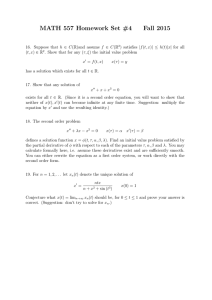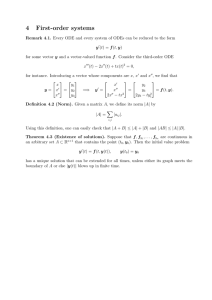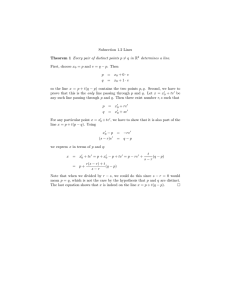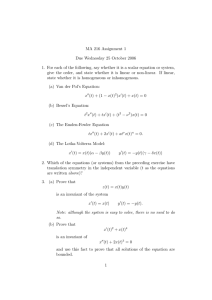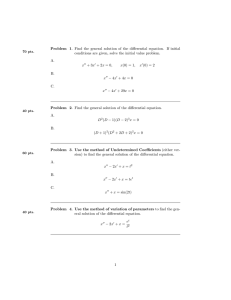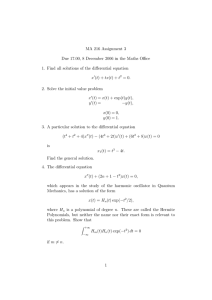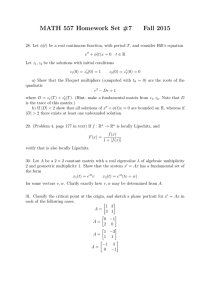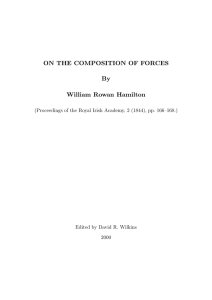Robust and Risk-Sensitive Output Feedback Control for Finite State Machines and
advertisement
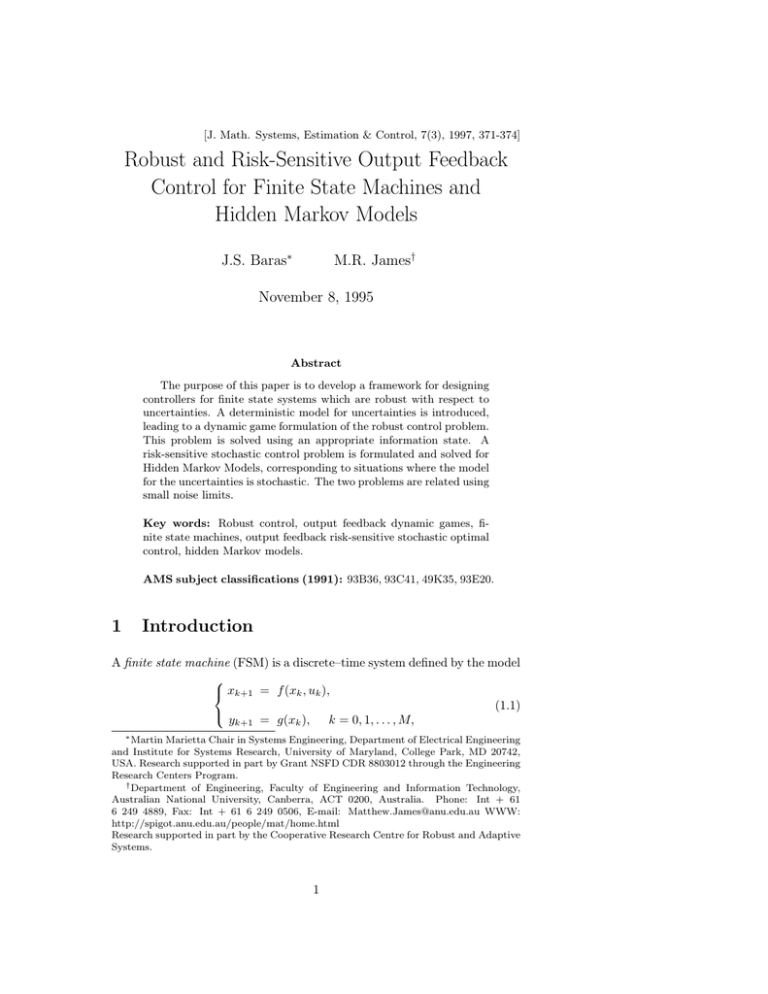
[J. Math. Systems, Estimation & Control, 7(3), 1997, 371-374]
Robust and Risk-Sensitive Output Feedback
Control for Finite State Machines and
Hidden Markov Models
J.S. Baras∗
M.R. James†
November 8, 1995
Abstract
The purpose of this paper is to develop a framework for designing
controllers for finite state systems which are robust with respect to
uncertainties. A deterministic model for uncertainties is introduced,
leading to a dynamic game formulation of the robust control problem.
This problem is solved using an appropriate information state. A
risk-sensitive stochastic control problem is formulated and solved for
Hidden Markov Models, corresponding to situations where the model
for the uncertainties is stochastic. The two problems are related using
small noise limits.
Key words: Robust control, output feedback dynamic games, finite state machines, output feedback risk-sensitive stochastic optimal
control, hidden Markov models.
AMS subject classifications (1991): 93B36, 93C41, 49K35, 93E20.
1
Introduction
A finite state machine (FSM) is a discrete–time system defined by the model
xk+1 = f (xk , uk ),
(1.1)
yk+1 = g(xk ),
k = 0, 1, . . . , M,
∗ Martin Marietta Chair in Systems Engineering, Department of Electrical Engineering
and Institute for Systems Research, University of Maryland, College Park, MD 20742,
USA. Research supported in part by Grant NSFD CDR 8803012 through the Engineering
Research Centers Program.
† Department of Engineering, Faculty of Engineering and Information Technology,
Australian National University, Canberra, ACT 0200, Australia. Phone: Int + 61
6 249 4889, Fax: Int + 61 6 249 0506, E-mail: Matthew.James@anu.edu.au WWW:
http://spigot.anu.edu.au/people/mat/home.html
Research supported in part by the Cooperative Research Centre for Robust and Adaptive
Systems.
1
where the state xk evolves in a finite set X, and the control uk and output
yk take values in finite sets U and Y, respectively. These sets have n, m,
and p elements, respectively. The behavior of the FSM is described by a
state transition map f : X × U → X and an output map g : X → Y.
FSM models, together with accompanying optimal control problems,
have been used widely in applications. However, it is typically the case
that deterministic treatments of such problems do not specifically deal with
disturbances, e.g., as arising from modelling errors, sensor noise, etc. In
this paper we propose and solve a general robust control problem for FSMs,
paralleling the framework that has been developed for linear systems (e.g.
Doyle et al [2]). The approach we adopt is motivated by [6], [7]. We thus
develop a general framework for robust output feedback control of FSMs
which specifically incorporates a deterministic model for disturbances and
their effects.
Hidden Markov Models (HMM) are a different but closely related class of
models, and numerous filtering, estimation, and control problems for them
have been proposed and employed in applications. These models use a probabilistic description of disturbances. However, the majority of applications
to date use a risk-neutral stochastic optimal control formulation. It is clear
from the work of Jacobson [4], Whittle [11] and others that a controller
more conservative than the risk-neutral one can be very useful. Indeed, it is
well known that risk-sensitive controllers are very closely related to robust
controllers, see [2], [6]. Here, we formulate and solve such a risk-sensitive
stochastic optimal control problem for HMMs. Our solution, which is interesting in itself, leads us to the solution of the robust control problem for
FSMs mentioned above. This is achieved by using a HMM which is designed
to be a small random perturbation of the FSM (1.1), and employing large
deviation limits as in [6]. It is possible to solve the robust control problem
directly using an appropriate information state, once it is known, as in [7]
(the large deviation limit identifies an information state).
The robust control problem for FSMs is formulated in §2; this entails
defining a deterministic disturbance mechanism with associated cost functions. In §3, a stochastic disturbance model and a risk-sensitive control
problem are defined. The risk-sensitive problem is solved, and a small noise
limit is evaluated and used in §4 to solve the robust control problem of §2.
2
2.1
Formulation of the Robust Control Problem
Deterministic Perturbation
The FSM model (1.1) predicts that if the current state is x and a control input u is applied, the next state will be x0 = f (x, u). However, a disturbance
may affect the actual system and result in a transfer to a state x00 6= x0
instead. Similarly, the model predicts the next output to be y 0 = g(x),
whereas a disturbance may cause an output y 00 6= y 0 to be observed. Additionally, the initial state x0 may be unknown, and consequently we shall
regard it as a disturbance.
2
We model the influence of disturbances as follows. Consider the following
FSM model with two additional (disturbance) inputs w and v:
xk+1 = b(xk , uk , wk ),
(2.1)
yk+1 = h(xk , vk ),
k = 0, 1, . . . , M,
where, wk and vk take values in finite sets W and V respectively, and as in
(1.1), xk ∈ X, yk ∈ Y, uk ∈ U. Thus x00 = b(x, u, w) for some w ∈ W, and
y 00 = h(x, v) for some v ∈ V.
The functions b : X × U × W → X and h : X × V → Y are required to
satisfy the following consistency conditions:
there exists w∅ ∈ W such that
(2.2)
b(x, u, w∅ ) = f (x, u) for all x ∈ X, u ∈ U,
there exists v∅ ∈ V such that
(2.3)
h(x, v∅ ) = g(x) for all x ∈ X.
The symbols w∅ and v∅ [8] play the role of “zero inputs”, so that when no
disturbances are present (i.e. wk ≡ w∅ , and vk ≡ v∅ ), the behavior of (2.1)
is the same as (1.1).
We will assume that there exists a null control u∅ ∈ U and an equilibrium
or rest state x∅ ∈ X such that
x∅ = f (x∅ , u∅ ).
The set of possible initial states is denoted N0 ⊂ X, and assumed to
contain x∅ , while the set of possible future states for the disturbance model
(2.1) is
NX (x, u) = {b(x, u, w) : w ∈ W} ⊂ X,
and the corresponding set of possible future outputs is
NY (x) = {h(x, v) : v ∈ V} ⊂ Y.
These sets can be thought of as “neighborhoods” of the nominal future
values f (x, u), g(x), and are determined by the maps b and h. These can
be designed as appropriate for the application at hand.
2.2
Cost Functions
To quantify the effect of the disturbances, a measure of their “sizes” is
required. To this end, one specifies functions
φw : W × X × U → R,
φv : V × X → R,
with the following properties:
φw (w∅ ; x, u) = 0 for all x ∈ X, u ∈ U,
β : X → R,
φw (w; x, u) > 0 for all w 6= w∅ ∈ W, x ∈ X, u ∈ U,
3
(2.4)
φv (v∅ ; x) = 0 for all x ∈ X,
and
(2.5)
φv (v; x) > 0 for all v 6= v∅ ∈ V, x ∈ X, u ∈ U,
β(x∅ ) = 0,
+∞ > β(x0 ) ≥ 0 for all x0 6= x∅ ∈ N0 ,
(2.6)
β(x0 ) = +∞ for all x0 6∈ N0 ,
We think of φw (w; x, u) as the magnitude of the disturbance w as it
affects the system when it is in state x with control u applied, and φ v (v; x)
as the magnitude of the disturbance v when in state x. Of course, null
disturbances are assigned zero cost. The cost function β specifies the amount
of uncertainty regarding the initial state. The two extreme choices are
(i) β(x0 ) = 0 for all x0 ∈ X (high uncertainty), and (ii) β(x0 ) = −δ∅
(certainty), where
0 if x = x0 ,
δx0 (x) =
−∞ if x 6= x0 .
Associated with these cost functions are quantities which define the optimal cost of transfering from x to x00 and the optimal cost of producing
the output y 00 . These quantities will be used in the solution of the robust
control problem below. They are defined by
4
U (x, x00 ; u) = minw∈W {φw (w; x, u) : x00 = b(x, u, w)} ,
(2.7)
00
4
00
V (x, y ) = minv∈V {φv (v; x) : y = h(x, v)} .
We adopt the convention that the minimum over an empty set equals +∞.
Thus U and V are extended real valued functions. Note that
U (x, f (x, u); u)
= 0
for all x ∈ X, u ∈ U,
U (x, b(x, u, w); u)
> 0
for all w 6= w∅ ∈ W, x ∈ X, u ∈ U,
U (x, x00 ; u) = +∞ if x00 6∈ NX (x, u).
and
V (x, g(x))
= 0
for all x ∈ X,
V (x, h(x, v))
> 0
for all v 6= v∅ ∈ V, x ∈ X,
V (x, y 00 ) = +∞ if y 00 6∈ NY (x).
2.3
Robust Control
As part of the problem specification, one defines an additional output quantity
zk+1 = `(xk , uk ),
(2.8)
4
where zk takes values in a finite set Z, and ` : X × U → Z. We assume
there exists a specific null element z∅ ∈ Z such that
`(x∅ , u∅ ) = z∅ .
A cost function for this output is also specified, with the properties
φz (z∅ ) = 0,
(2.9)
(2.10)
φz (z) ≥ 0 for all z ∈ Z.
The output quantity z and its associated cost function φz encode the performance objective of the problem at hand. To summarize, the complete
system is described by the equations
xk+1 = b(xk , uk , wk ),
zk+1 = `(xk , uk ),
(2.11)
yk+1 = h(xk , vk ),
k = 0, 1, . . . , M.
The state variable xk is not measured directly, and so the controller
must make use of information available in the output signal y0,k ; i.e., the
controller must be an output feedback controller. We denote by Ok,l the
set of non–anticipating control policies defined on the interval [k, l]; i.e.,
those controls for which there exist functions ūj : Yj−k+1 → U such that
uj = ūj (yk+1,j ) for each j ∈ [k, l].
The output feedback robust control problem we wish to solve is the following: given γ > 0 and a finite time interval [0, M ] find an output feedback
controller u ∈ O0,M −1 such that
M
−1
X
φz (zk+1 ) ≤ β(x0 ) + γ
k=0
M
−1
X
(φw (wk ; xk , uk ) + φv (vk ; xk ))
(2.12)
k=0
for all (w, v) ∈ WM × VM , x0 ∈ X.
Remark 2.1 The formulation of this problem is similar to the H∞ problem
in the time domain for nonlinear systems [7], motivated by the formulation
for linear systems [2].
2.4
Dynamic Game
The robust control problem formulated above can be recast as a dynamic
game problem, see, e.g., [7] and the references contained therein. The payoff
function for a controller u ∈ O0,M −1 (player 1) and disturbances (w, v, x0 ) ∈
WM × VM × X (player 2) is given by
4
J γ (u, w, v, x0 ) = −β(x0 )+
M
−1
X
φz (zk+1 )−γ (φw (wk ; xk , uk ) + φv (vk ; xk )) .
k=0
5
We consider the upper game for this payoff given the dynamics (2.1).
Define
4
J γ (u) =
max
max {J γ (u, w, v, x0 )} .
(w,v)∈WM ×VM x0 ∈X
The bound
0 ≤ J γ (u) ≤ M max φz (z)
(2.13)
z∈Z
is readily verified. The dynamic game problem is to find an output feedback
controller u∗ ∈ O0,M −1 such that
J γ (u∗ ) =
Then if
min
u∈O0,M −1
J γ (u).
(2.14)
J γ (u∗ ) = 0,
(2.15)
the robust control objective (2.12) is achieved.
We will solve this dynamic game problem in §4.
2.5
State Feedback Robust Control
For completeness and clarity, we consider now the solution of the robust
control problem in the special case where complete state information is
available. In this case, g(x) ≡ x and h(x, v) ≡ x, so that yk+1 = xk for all
k, and Ok,l = Sk,l , the class of U–valued non–anticipating functions of the
state xk,l .
The state feedback robust control problem is to find a controller u ∈
S0,M −1 such that
M
−1
X
φz (zk+1 ) ≤ γ
k=0
M
−1
X
φw (wk ; xk , uk )
(2.16)
k=0
for all w ∈ WM , given x0 = x∅ , and γ > 0.
The equivalent dynamic game problem is to find u∗ ∈ S0,M −1 such that
J γ (u∗ ) =
min
u∈S0,M −1
J γ (u) = 0,
(2.17)
where now
4
J γ (u) =
max
w∈WM
(M −1
X
φz (zk+1 ) − γφw (wk ; xk , uk ) : x0 = x∅
k=0
)
.
Note that
0 ≤ J γ (u) ≤ M max φz (z).
z∈Z
(2.18)
The upper value function for this game is defined by
(M −1
)
X
4
γ
f¯k (x) =
min
max
φz (zl+1 ) − γφw (wl ; xl , ul ) : xk = x ,
u∈Sk,M −1 w∈WM −k
l=k
(2.19)
6
and the corresponding dynamic programming equation is
γ
γ
(b(x, u, w)) + φz (`(x, u))
f¯k (x) = minu∈U maxw∈W {f¯k+1
−γφw (w; x, u)}
¯γ
fM (x) = 0.
(2.20)
Theorem 2.2 (Necessity) Assume that us ∈ S0,M −1 solves the state feedback robust control problem. Then there exists a solution f¯γ to the dynamic
programming equation (2.20) such that f¯kγ (x) ≥ 0, f¯0γ (x∅ ) = 0. (Sufficiency)
Assume that there exists a solution f¯γ of the dynamic programming equation (2.20) such that f¯kγ (x) ≥ 0, f¯0γ (x∅ ) = 0. Let ũ∗k (x) be the control value
achieving the minimum in (2.20). Then ũ∗k (x) is a state feedback controller
which solves the state feedback robust control problem (2.16).
Proof. For x ∈ X, k ∈ [0, M ] define f¯kγ (x) by (2.19). Then we have
0 ≤ f¯kγ (x) ≤ β(x),
for some constant β(x) depending on M . By dynamic programming f¯γ
solves equation (2.20). By definition,
f¯0γ (x∅ ) ≤ J γ (us ) ≤ 0,
and so f¯0γ (x∅ ) = 0. This proves the necessity part.
As for sufficiency, standard dynamic programming arguments and the
hypotheses imply that
0 = f¯0γ (x∅ ) = J γ (u∗ ).
Therefore by (2.17) we see that u∗ solves the state feedback robust control
problem.
2
3
A Risk–Sensitive Stochastic Control Problem
In this section we formulate and solve a risk-sensitive stochastic control
problem for Hidden Markov Models (HMM). While the particular HMM
treated is a random perturbation of the FSM (1.1), [5], the method applies
more generally.
3.1
Random Perturbation
The random perturbation defined below is a stochastic analog of the deterministic perturbation introduced in §2, and indeed much of the notation
from §2 will be used here.
A controlled Hidden Markov Model consists of an X valued controlled
Markov chain xεk together with a Y valued output process ykε whose behavior
7
is determined by a state transition matrix Aε (u) and an output probability
matrix B ε (x) [9]. These matrices are defined by their components
4
1
ε
Zx,u
4
1
Zxε
Aε (u)x,x00 =
ε
B (x)y00 =
¡
¢
exp − 1ε U (x, x00 ; u) ,
exp
¡
− 1ε V
00
(3.1)
¢
(x, y ) ,
where the functions U and V are defined by (2.7), and the normalizing
ε
and Zxε are chosen so that
constants Zx,u
X
X
Aε (u)x,x00 = 1,
B ε (x)y00 = 1.
x00 ∈X
y 00 ∈Y
Similarly, an initial distribution can be defined by
¡
¢
ρε (x0 ) = Z1ε exp − 1ε β(x0 ) .
x0
(3.2)
Thus
¡
¢
Pu xεk+1 = x00 | xk = x, x0,k−1 , uk = u, u0,k−1 = Aε (u)x,x00 ,
and
¡ ε
¢
Pu yk+1
= y 00 | xk = x = B ε (x)y00 ,
where Pu is the probability distribution on XM +1 ×YM defined by a control
policy u ∈ O0,M −1 :
M −1 ε
Pu (x0,M , y1,M ) = Πk=0
A (uk )xk ,xk+1 B ε (xk )yk+1 ρε (x0 )
The HMM (3.1) satisfies the consistency conditions
lim Aε (u) = A(u),
lim B ε (x) = B(x),
ε→0
where
A(u)x,x00 =
B(x)y00 =
ε→0
1 if x00 = f (x, u),
0 if x00 6= f (x, u),
1 if y 00 = g(x),
0 if y 00 6= g(x).
If β has a unique minimum at x∅ , then
lim ρε (x0 ) = ρ(x0 ),
ε→0
where
ρ(x0 ) =
Thus if
xε0
→ x∅ , we have
1 if x0 = x∅ ,
0 if x0 6= x∅ .
ε
) → (x0,M , y1,M )
(xε0,M , y1,M
in probability as ε → 0, where (x0,M , y1,M ) are the state and output paths
for the FSM with the same control policy and initial condition. Therefore
the HMM (3.1) is indeed a random perturbation of the FSM (1.1).
8
The probability distribution Pu is equivalent to a distribution P† under
which {ykε } is iid uniformly distributed on Y, independent of {xεk }, and
{xεk } is a controlled Markov chain as above:
´
³
M −1
P† (x0,M , y1,M ) = Πk=0
Aε (uk )xk ,xk+1 p1 ρε (x0 ),
where p here denotes the number of outputs. Note that
dPu
4
|G = λεk = Πkl=1 Ψε (xεl−1 , ylε ),
dP† k
where
4
Ψε (x, y 00 ) = pB ε (x)y00 ,
ε
and Gk is the filtration generated by (xε0,k , y1,k
).
Remark 3.1 λεk is the Radon-Nikodym derivative of Pu with respect to
P† on the measurable space (XM +1 × YM , Gk ), and has the explcit form
given. As a consequence, for a GM -measurable random variable Ξ,
Z
Z
4
4
Eu [Ξ] = ΞdPu = ΞλεM dP† = E† [λεM Ξ].
3.2
Cost
The cost function is defined for admissible u ∈ O0,M −1 by
"
#
M −1
1 X
γ,ε
u
ε
J (u) = E exp
φz (`(xl , ul ))
γε
(3.3)
l=0
and the output feedback risk-sensitive stochastic control problem for the
HMM (3.1) is to find u∗ ∈ O0,M −1 such that
J γ,ε (u∗ ) =
min
u∈O0,M −1
J γ,ε (u).
Remark 3.2 The risk-sensitive cost (3.3) was introduced by Jacobson [4] in
the context of linear systems and quadratic cost functions, and was refered
to as LEQG. This cost measure was further studied by Whittle [10], [11]
and others. The exponential appearing in (3.3) does not commute with the
expectation, and so the risk-sensitive cost is fundamentally different to the
more familiar risk-neutral cost
"M −1
#
X
u
ε
E
φz (`(xl , ul )) .
l=0
The exponential has the effect of heavily penalizing large values of the sum,
leading to a controller which is more conservative, or risk-sensitive. This
latter terminology comes from economics.
In terms of the reference measure, the cost can be expressed as
"
#
M −1
1 X
γ,ε
†
ε
ε
J (u) = E λM exp
φz (`(xl , ul )) .
γε
l=0
9
(3.4)
3.3
Information State
Following [6], we define an information state process σkγ,ε ∈ Rn by the
relation
"
#
k−1
1 X
γ,ε
†
ε
ε
(3.5)
σk (x) = E I{xεk =x} exp
φz (`(xl , ul )) λk | Yk ,
γε
l=0
ε
where Yk is the filtration generated by the observation process y1,k
, and
γ,ε
σ0 (x) = I{x=x∅ } .
The evolution of this process is determined by a matrix Σγ,ε (u, y 00 ) whose
entries are defined by
4
Σγ,ε (u, y 00 )x,x00 = Aε (u)x,x00 Ψε (x, y 00 ) exp
1
φz (`(x, u)) .
γε
Indeed, the information state is the solution of the recursion
γ,ε
γ,ε
σk = Σγ,ε ∗ (uk−1 , ykε ) σk−1
σ0γ,ε = ρε ,
(3.6)
(3.7)
where the ∗ denotes matrix transpose.
Remark 3.3 The recursion (3.7) is similar to the recursion formula for the
unnormalized conditional distribution in nonlinear filtering, see, e.g. [9].
The derivation of (3.7) appears in [6].
We can also define an adjoint process νkγ,ε ∈ Rn by the recursion
γ,ε
γ,ε
νk−1 = Σγ,ε (uk−1 , ykε ) νk
γ,ε
νM
= 1.
(3.8)
Then relative to the inner product
hσ, νi =
X
σ(x)ν(x)
x∈X
for σ, ν ∈ Rn , it is straightforward to establish the adjoint relationships
hΣγ,ε ∗ σ, νi = hσ, Σγ,ε νi,
γ,ε
γ,ε
i
, νk−1
hσkγ,ε , νkγ,ε i = hσk−1
(3.9)
for all σ ∈ Rn , ν ∈ Rn , and all k.
Remark 3.4 The reason for introducing the information state σkγ,ε is to
replace the original output feedback risk-sensitive stochastic control problem with an equivalent stochastic control problem with a state variable σ kγ,ε
which is completely observed, and to solve this new problem using dynamic
programming. This will yield a state feedback controller for the new problem, or equivalently, an output feedback controller for the original problem
which is separated through the information state [9], [1], [6].
10
As in [6], the cost function can be expressed purely in terms of the
information state:
γ,ε
J γ,ε (u) = E† [hσM
, 1i] .
(3.10)
To see this, observe that for u ∈ O0,M −1
γ,ε
E† [hσM
, 1i]
= E†
hP
x∈X
ii
h
PM −1
1
ε
ε
E† I{xεM =x} exp γε
l=0 φz (`(xl , ul )) λM | YM
i
h
PM −1
1
ε
ε
φ
(`(x
,
u
))
λ
= E† exp γε
z
l
M
l
l=0
= J γ,ε (u).
3.4
Dynamic Programming
Consider the state σ γ,ε on the interval k, . . . , M with initial condition σkγ,ε =
σ ∈ Rn :
γ,ε
γ,ε
σl = Σγ,ε ∗ (ul−1 , ylε ) σl−1 , k + 1 ≤ l ≤ M,
(3.11)
γ,ε
σk = σ.
The corresponding value function for this control problem is defined for
σ ∈ Rn by
S γ,ε (σ, k) =
min
u∈Ok,M −1
γ,ε
E† [hσM
, 1i | σkγ,ε = σ] .
(3.12)
The dynamic programming equation for this problem is as follows [6]:
γ,ε
£
¤
ε
)σ, k + 1)
S (σ, k) = minu∈U E† S γ,ε (Σγ,ε ∗ (u, yk+1
(3.13)
γ,ε
S (σ, M ) = hσ, 1i.
The next theorem is a statement of the dynamic programming solution
to the output feedback risk-sensitive stochastic control problem.
Theorem 3.5 The value function S γ,ε defined by (3.12) is the unique solution to the dynamic programming equation (3.13). Conversely, assume
that S γ,ε is the solution of the dynamic programming equation (3.13). Suppose that u∗ ∈ O0,M −1 is a policy such that, for each k = 0, . . . , M − 1,
u∗k = ū∗k (σkγ,ε ), where ū∗k (σ) achieves the minimum in (3.13). Then u∗ is an
optimal output feedback controller for the risk–sensitive stochastic control
problem (§3.2).
Proof. The proof is similar to those of Theorems 2.5 and 2.6 in [6]
(see also [9]).
Let S γ,ε (σ, k) denote the solution to the dynamic programming equation
(3.13). We will show that S γ,ε (σ, k) equals the RHS of (3.12) and that the
policy u∗ is optimal. To this end, define
S̄ γ,ε (σ, k; u) = E† [hσkγ,ε , νkγ,ε i | σkγ,ε = σ] .
11
We claim that, for all u ∈ Ok,M −1 ,
S γ,ε (σ, k) ≤ S̄ γ,ε (σ, k; u)
(3.14)
for each k = 0, 1, . . . , M , with equality if u = u∗ .
For k = M , (3.14) is clearly satisfied. Assume now that (3.14) holds for
k + 1, . . . , M . Then
S̄ γ,ε (σ, k; u)
¤
¤
£ £
γ,ε
ε
(uk+1,M −1 )i | Yk+1 | σkγ,ε = σ
= E† E† hΣγ,ε ∗ (uk , yk+1
)σkγ,ε , νk+1
£
¤
ε
= E† S̄ γ,ε (Σγ,ε ∗ (uk , yk+1
)σ, k + 1; uk+1,M −1 )
£
¤
ε
≥ E† S γ,ε (Σγ,ε ∗ (uk , yk+1
)σ, k + 1)
≥ S γ,ε (σ, k)
using the induction hypothesis and (3.13). If u = u∗ the above inequalities
are replaced by equalities. This proves (3.14), and hence that S γ,ε (σ, k)
equals the RHS of (3.12).
From (3.14), setting k = 0 and σ = ρε we obtain
S̄ γ,ε (ρε , 0; u∗ ) = S µ,ε (ρε , 0) ≤ S̄ γ,ε (ρε , 0; u)
for any u ∈ O0,M −1 . This implies
J γ,ε (u∗ ) ≤ J γ,ε (u)
for all u ∈ O0,M −1 . This completes the proof.
2
Remark 3.6 Note that the controller u∗k is defined as a function of the
ε
information state σkγ,ε , and since σkγ,ε is a non-anticipating function of y0,k
,
∗
uk is an output feedback controller for the risk-sensitive stochastic control
problem; indeed, u∗ is an information state feedback controller.
3.5
Small Noise Limit
In [6] it was shown that a deterministic dynamic game problem is obtained
as a small noise limit of a risk–sensitive stochastic control problem. In this
subsection, we carry out this limit procedure for the risk-sensitive stochastic
control problem defined above. We first obtain a limit for the information
state, and use this to evaluate the appropriate limit for the value function.
This yields an information state and value function for the dynamic game
problem of §2.4. These results will be used in §4 in the solution of the
output feedback robust control problem of §2.
Define the matrix Λγ (u, y 00 ) by its entries
4
Λγ (u, y 00 )x,x00 = φz (`(x, u)) − γ (U (x, x00 ; u) + V (x, y 00 )) .
(3.15)
Then we have
lim γε log Σγ,ε (u, y 00 )x,x00 = Λγ (u, y 00 )x,x00 .
ε→0
12
(3.16)
The action of the matrix Σγ,ε and its adjoint (transpose) on vectors σ, ν
in Rn is given by the usual matrix multiplication, i.e., sums of products of
entries. The action of the matrix Λγ (u, y 00 ) and its adjoint on vectors p, q
in Rn is instead defined in terms of maximization operations as follows:
4
Λγ ∗ (u, y 00 )p(x00 ) = maxx∈X {Λγ (u, y 00 )x,x00 + p(x)} ,
(3.17)
4
Λγ (u, y 00 )q(x) = maxx00 ∈X {Λγ (u, y 00 )x,x00 + q(x00 )} .
The inner product h · , · i is replaced by the “sup-pairing”
4
(p, q) = max {p(x) + q(x)} ,
x∈X
(3.18)
and in fact we have
1
1
p
q
lim γε loghe γε , e γε i = (p, q).
ε→0
(3.19)
The actions corresponding to the matrix Λγ (u, y 00 ) are “adjoint” in the sense
that
(Λγ ∗ p, q) = (p, Λγ q) .
(3.20)
The limit result for the information state is the following:
Theorem 3.7 We have
1
limε→0 γε log Σγ,ε ∗ (u, y)e γε p = Λγ ∗ (u, y)p,
(3.21)
limε→0 γε log Σ
γ,ε
(u, y)e
1
γε q
γ
= Λ (u, y)q
in Rn uniformly on U × Y × Rn .
Proof. First note that, using Lemma A.1,
ε
lim ε log Zx,u
= 0, and lim ε log Zxε = 0.
ε→0
ε→0
Next, for a = (x00 , u, y, p) define
ε
Faε (x) = Fa (x) − ε log Zx,u
− ε log Zxε ,
Fa (x) = (Λγ (u, y)x,x00 + p(x))/γ.
Then
1
Σγ,ε ∗ (u, y)e γε p (x00 ) =
X
ε
eFa (x)/ε ,
x∈X
and the first limit result follows using Lemma A.1. The second limit is
proven similarly.
2
In view of this theorem, we define a limit information state and its
adjoint by the recursions
γ
γ
pk = Λγ ∗ (uk−1 , yk )pk−1
(3.22)
γ
p0 = −β,
13
and
γ
γ
qk−1 = Λγ (uk−1 , yk )qk
Note that
γ
qM
= 0.
(3.23)
γ
)
(pγk , qkγ ) = (pγk−1 , qk−1
for all k.
Turning now to the value function, we have:
Theorem 3.8 The function W γ (p, k) defined for p ∈ Rn by
4
1
W γ (p, k) = lim γε log S γ,ε (e γε p , k)
ε→0
(3.24)
exists (i.e. the sequence converges uniformly on Rn ), is continuous, and
satisfies the recursion
W γ (p, k) = minu∈U maxy∈Y {W γ (Λγ ∗ (u, y)p, k + 1)}
(3.25)
γ
W (p, M ) = (p, 0) .
Proof. First note that the solution of the recursion (3.25) is a continuous function on Rn for each k (this is readily verified by induction).
Assume the conclusions hold for k + 1, . . . , M . From Theorem 3.5 and
(3.24), we need to compute
1
limε→0 γε log S γ,ε (e γε p , k)
h
i
1
ε
)e γε p , k + 1)
= limε→0 γε log minu∈U E† S γ,ε (Σγ,ε ∗ (u, yk+1
(3.26)
i
h
1
ε
= limε→0 minu∈U γε log E† S γ,ε (Σγ,ε ∗ (u, yk+1
)e γε p , k + 1) .
The last equality is due to the monotonicity of the logarithm function.
By Theorem 3.7,
1
4
p
4
pεa = γε log Σγ,ε, ∗ (u, y 00 )e γε → pa = Λγ (u, y 00 )p
as ε → 0 uniformly in a = (u, y 00 , p). It then follows from the induction
hypothesis and continuity that
1
lim γε log S γ,ε (e γε
ε→0
pεa
, k + 1) = W γ (pa , k + 1)
uniformly in a. Next, applying Lemma A.1, we obtain
P
1
limε→0 γε log y00 ∈Y p1 S γ,ε (Σγ,ε ∗ (u, y 00 )e γε p , k + 1)
= maxy00 ∈Y W γ (Λγ, ∗ (u, y 00 )p, k + 1)
uniformly in (u, p). Therefore the RHS of (3.26) equals
min max {W γ (Λγ ∗ (u, y)p, k + 1)} ,
u∈U y∈Y
and the limit is uniform in p.
2
14
4
Solution to the Robust Control Problem
4.1
Equivalent Game Problem
We now replace the deterministic output feedback game problem (§2) with
an equivalent deterministic game problem with pγk , defined in §3.5, as a
completely observed state variable. The solution of this new problem will
result in an information state feedback controller, and thus an output feedback controller for the original game problem which is separated through
the information state.
The next theorem shows that the cost function can be expressed in terms
of the information state [6], [1].
Theorem 4.1 We have for all u ∈ O0,M −1
J γ (u) = max {(pγM , 0)} .
(4.1)
y∈Y M
Proof. We have, for all u ∈ O0,M −1 ,
maxy∈YM {(pγM , 0)}
= maxy∈YM maxx00 ∈X {pγM (x00 )}
= maxy∈YM maxξ∈XM +1 {−β(ξ0 ) +
PM −1
l=0
φx (`(ξl , ul ))
−γ (U (ξl , ξl+1 ; ul ) + V (ξl , yl+1 ))}
= maxw∈WM maxv∈VM maxx0 ∈X {J γ (u, w, v, x0 )}
= J γ (u),
where we have made use of the definitions for the cost functions U and V
(§2.2).
2
4.2
Dynamic Programming
Consider now the state pγ on the interval k, . . . , M with initial condition
pγk = p ∈ Rn :
γ
γ
pl = Λγ ∗ (ul−1 , yl )pl−1 , k + 1 ≤ l ≤ M,
(4.2)
γ
pk = p.
The value function is defined for p ∈ Rn by
W γ (p, k) =
min
max {(pγM , 0) : pγk = p} .
u∈Ok,M −1 y∈Y M −k
The solution of the game problem is expressed as follows.
15
(4.3)
Theorem 4.2 The value function W γ (p, k) defined by (4.3) is the unique
solution to the dynamic programming equation (3.25). Further, if W γ (p, k)
is the solution of (3.25), and if u∗ ∈ O0,M −1 is a policy such that, for
each k = 0, . . . , M − 1, u∗k = ū∗k (pγk ), where ū∗k (p) achieves the minimum in
(3.25), then u∗ is an optimal policy for the output feedback dynamic game
problem (§2.4).
Proof. Standard dynamic programming arguments, similar to those
employed in the proof of Theorem 3.5, show that the function W γ (p, k)
defined by (4.3) is the solution to the dynamic programming equation (3.25),
and
W γ (−β, 0) = J γ (u∗ ) =
min J γ (u).
u∈O0,M −1
Therefore u∗ is optimal.
4.3
2
Robust Control
The solution to the state feedback robust control problem (§2.5) was expressed in terms of the solution f¯kγ (x) of a dynamic programming equation,
and a state feedback controller ũ∗k (x) was obtained. The framework we have
developed in this paper allows us to characterize the solution of the output feedback robust control problem in terms of the solution W γ (p, k) of a
dynamic programming equation, and obtain an output feedback controller
ū∗k (pγk (· ; y1,k )). Note that the information state pγk is also the solution of a
dynamic programming equation (3.22).
Theorem 4.3 (Necessity) Assume that there exists an output feedback controller uo ∈ O0,M −1 solving the output feedback robust control problem.
Then there exists a solution W γ (p, k) of the dynamic programming equation (3.25) such that W γ (−β, 0) = 0. (Sufficiency) Assume that there exits
a solution W γ (p, k) of the dynamic programming equation (3.25) such that
W γ (−β, 0) = 0, and let ū∗k (p) be a control value achieving the minimum in
(3.25). Then ū∗k (pγk (· ; y1,k )) is an output feedback controller which solves
the output feedback robust control problem.
Proof. Define W γ by (4.3). Then by Theorem 4.2 we know that W γ
is the solution of the dynamic programming equation (3.25). Next, we have
0 ≤ W γ (−β, 0) =
min
u∈O0,M −1
J γ (u) ≤ J γ (uo ) ≤ 0,
and so W γ (−β, 0) = 0.
To prove sufficiency, by Theorem 4.2 we have
0 = W γ (−β, 0) = J γ (u∗ ),
which is the same as (2.15). Therefore u∗ solves the output feedback robust
control problem.
2
16
A
Appendix
The following theorem is a version of the Varadhan-Laplace lemma [3].
Lemma A.1 Let A be a subset of Rm , and Faε , Fa be real valued functions
defined on a finite set X such that
lim sup max |Faε (x) − Fa (x)| = 0.
ε→0 a∈A x∈X
Then
lim sup |ε log
ε→0 a∈A
X
ε
eFa (x)/ε − max Fa (x)| = 0.
x∈X
x∈X
(A.1)
Proof. Write F̄aε = maxx∈X Faε (x), F̄a = maxx∈X Fa (x). Our assumptions ensure that
(A.2)
lim sup |F̄aε − F̄a | = 0.
ε→0 a∈A
Since the maximums are achieved, we deduce
X ε
ε
ε
eF̄a /ε ≤
eFa (x)/ε ≤ neF̄a /ε .
x∈X
Take logarithms and multiply by ε to get
X ε
F̄aε ≤ ε log
eFa (x)/ε ≤ ε log n + F̄aε .
x∈X
Then using (A.2) we deduce (A.1) as desired.
2
References
[1] A. Bensoussan and J.H. van Schuppen, Optimal Control of Partially
Observable Stochastic Systems with an Exponential-of-Integral Performance Index, SIAM J. Control Optim., 23 (1985) 599—613.
[2] J.C. Doyle, K. Glover, P.P. Khargonekar and B.A. Francis, State-Space
Solutions to Standard H2 and H∞ Control Problems, IEEE Trans. Aut.
Control, AC–34 (8) (1989) 831—847.
[3] M.I. Friedlin and A.D. Wentzell, “Random Perturbations of Dynamical
Systems”, Springer-Verlag, New York, 1984.
[4] D.H. Jacobson, Optimal Stochastic Linear Systems with Exponential
Performance Criteria and their Relation to Deterministic Differential
Games, IEEE Trans. Aut. Control, AC-18-2 (1973) 124—131.
[5] M.R. James, Finite Time Observer Design by Probabilistic-Variational
Methods, SIAM J. Control Optim., 29(4) (1991) 954—967.
[6] M.R. James, J.S. Baras and R.J. Elliott, Risk–Sensitive Control and
Dynamic Games for Partially Observed Discrete-Time Nonlinear Systems, IEEE Trans. Aut. Control, AC-39-4 (1994) 780—792.
17
[7] M.R. James and J.S. Baras, Robust H∞ Output Feedback Control for
Nonlinear Systems, IEEE Trans. Aut. Control, 40(6) (1995) 1007—
1017.
[8] R.E. Kalman, P.L. Falb and M.A. Arbib, “Topics in Mathematical
System Theory”, McGraw-Hill, New York, 1969.
[9] P.R. Kumar and P. Varaiya, “Stochastic Systems: Estimation, Identification, and Adaptive Control”, Prentice-Hall, Englewood Cliffs, 1986.
[10] P. Whittle, Risk-Sensitive Linear/Quadratic/Gaussian Control, Adv.
Appl. Prob., 13 (1981) 764—777.
[11] P. Whittle, “Risk-Sensitive Optimal Control”, Wiley, New York, 1990.
18
